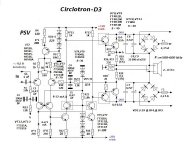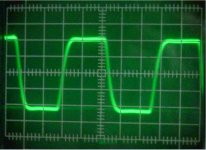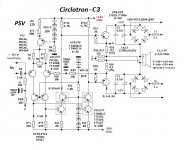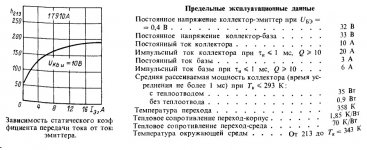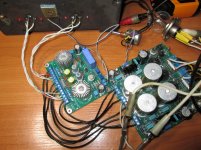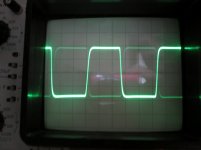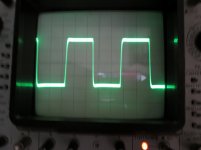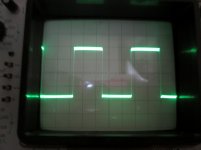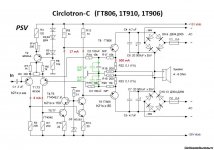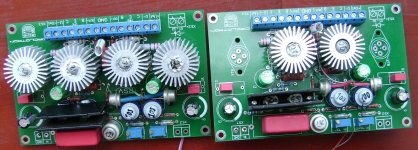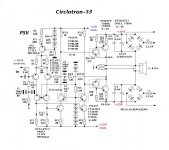I report for almost a year's work. Labor is collective.
Series of amplifiers Cyclothers of different configurations. In order to fully utilize the elemental base of germanium semiconductors.
The power band was able to extend from 30-50 to 600 kHz.
Power up to 36 watts. Maybe more.
Amplifiers are very stable.
Stable resting current. Stable output voltage, zero.
Two of the four diodes (VD1-4) are temperature sensors. Placed on radiators
Meander at 100 kHz.
Series of amplifiers Cyclothers of different configurations. In order to fully utilize the elemental base of germanium semiconductors.
The power band was able to extend from 30-50 to 600 kHz.
Power up to 36 watts. Maybe more.
Amplifiers are very stable.
Stable resting current. Stable output voltage, zero.
Two of the four diodes (VD1-4) are temperature sensors. Placed on radiators
Meander at 100 kHz.
Attachments
Last edited:
The biggest curiosity is the Cyclotron with a single transistor on the output.
Sounds like one hand clapping...
Sounds like one hand clapping...
The best sound option is currently.
Feature of germanium transistors - increase of gain with increasing current.
On the graph, the dependence of the "beta" indicator on current. For 1T910AD
This also applies to other transistors of the circuit.
Attachments
Last edited:
The previous version of the scheme, more simple. 1kHz, 10kHz, 20kHz.
Sinus: 0dB - 70kHz, -3db - 180kHz.
Sinus: 0dB - 70kHz, -3db - 180kHz.
Attachments
Well i know the next project I have been looking for something like this for years !
Do you think i will work well with silicon output devices ? I would like to know the standing current I assume this is a class A device
Regards Trev
Do you think i will work well with silicon output devices ? I would like to know the standing current I assume this is a class A device
Regards Trev
Very nice. I like the Circlotron-C best and would make it even simpler by omitting T5 and T7.
@latala
I would certainly try this topology with some modifications.
@latala
I would certainly try this topology with some modifications.
Very nice job ! With MosFet transistors the result should be interesting too, since there is no gain drop at high intensity, and the frequency response is very wide.
I listened to this amplifier with silicone 3055. With germanium, the sound is different. Not better or worse, just different.
standing current 400mA (min 200mA)
standing current 400mA (min 200mA)
Very nice job ! With MosFet transistors the result should be interesting too, since there is no gain drop at high intensity, and the frequency response is very wide.
Yes, with lateral MOSFET.
Suggestion:
JFET-bipolar cascode input, grounded-base driver, lateral MOSFET output.
Trev, maybe not what you were taught in school? However, the VAS buffer and the cascoded VAS (British iventions) have no physical foundation, but are based on incorrect assumptions and some mathematical gibberish.
I soldered variant D3. Frequency respouse: 17 Hz - 260 kHz (-3 dB). Current - 250 mA. Meander at 100 kHz.
http://devicemusic.ucoz.ru/_fr/2/s0060778.jpg
http://devicemusic.ucoz.ru/_fr/2/s0060778.jpg
Attachments
do you have the schematic that u used with 2n3055 i would like to see that
i would build it it even though it has so many power supplies
i would build it it even though it has so many power supplies
I tried to put of darlington TIP147, everything was OK.
clipping sine wave - TIP147:
http://devicemusic.ucoz.ru/_fr/2/s5586742.jpg
Current - 200 mA.
clipping sine wave - TIP147:
http://devicemusic.ucoz.ru/_fr/2/s5586742.jpg
Current - 200 mA.
do you have the schematic that u used with 2n3055 i would like to see that
i would build it it even though it has so many power supplies
Svjatoslav has a circuit of Sziklai.
- Home
- Amplifiers
- Solid State
- The Germanium-only circlotrons. Powerful, wideband.
